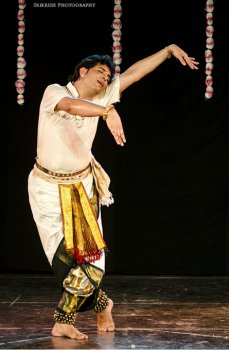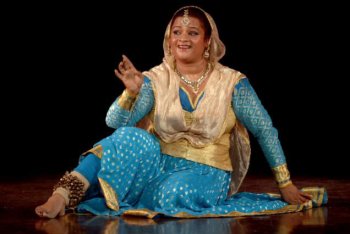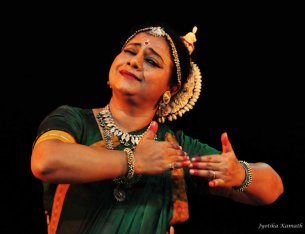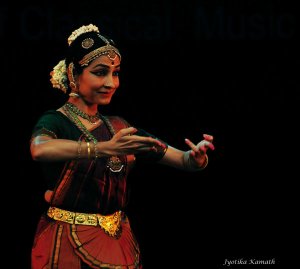
|   |

|   |
Ancient traditions, Modern banis - Ashish Mohan Khokar e-mail: khokar1960@gmail.com December 5, 2013 Continuing on theme and subject of banis (thanks to spin-off of Alarmel Valli's Oct. focus on her own bani, of which she is a worthy representative) I bring to you two artistes - Aniruddha Knight, grandson of the great Bala and Murali Mohan Kalva, grand student of Sunderlal Gangani. Aniruddha represents the Bala bani (Balamma, in figure of speech, left the Tanjore bani - to which she was born - far behind and even surpassed it) and Murali Mohan Kalva has taken the Jaipur gharana far ahead. At the poorly attended 7th Nartaka Festival (Nov 8-10, Bharatiya Vidya Bhavan, Chennai), Aniruddha proved his mettle. In each item he did, there was depth of tradition and substance of content. When he had performed a decade and half ago in Chennai in some far flung hall in T. Nagar, all of Madras had turned up to see what Balamma's only grandson had to offer and they went away chuckling and mumbling, rather disappointed. They claimed he neither sat nor maintained an araimandi position properly, nor had any evident humility, so important in Madras, where fake humility and surface level impressions are so important. Often, a dancer or guru is liked on impressions formed, not necessarily quality of art or work. This is also true of rest of India. Thus, when a member of Balamma's family performs, the expectations are far more and so is the resultant outcome. Last time I saw him perform, some 15-17 years ago, I thought he was doing Kathak, for he was attired in kurta and pyjama and hardly sat in araimandi position, as one should in Bharatanatyam. This time, all of 33+, he showed the great shades of Balamma's art. In each item he maintained an araimandi, articulated each hasta in detail, and all rendition was soaked in musicality for which the style is so known. He occasionally couldn't help his good gene (for they were all great singers and musicians, the Veena Dhanammal - Bala family) and sang along in most pieces, showing a firm grasp on music for dance. Balamma was great not because she was a great dancer but she was a great dancer who understood and knew music, intrinsically. This is the key. Musicality. Bala understood it. M.K. Saroja, Vyjayanthimala and Alarmel Valli too have this quality. And Padma Subrahmanyam. That's why their dance is not routine, going through the paces but woven artistry, whose bedrock is musicality. Not just raga, tala, laya structure and delivering to that but the whole body absorbs and dances to music.  Aniruddha entered the stage minus fake mannerisms. Humility - so important in South to be accepted in art circles - also showed, as he first tilted sideways, at the waist with folded hands, before starting each item. He is tall, too tall for stage but bears his height well and looks royal. He knows his place in the sun and strides the stage like a lion king! His bio-data is a case of clever writing American style, for on one side he claims inheritance from a great tradition and yet doesn't wish to be measured by it (Nupura brochure festival in Bangalore). That he acquitted himself with top marks and appreciation from connoisseurs like Chairperson of the Sangeet Natak Akademi, Leela Samson, the chief guest, showed Ani's final arrival on serious dance scene of Madras. Bhavnagar in Gujarat is another dusty, obscure middle-of-nowhere town. Murali Mohan Kalva hails from here. Though of Telugu extraction, he learnt from Dharmashi Shah, disciple of great Kathak gharana guru Sunderlal Gangani. When a Bhavnagar boy comes to Bangalore and ignites the Kathak dance scene slowly, he leaves all established folks behind. Today, based in Bangalore, Murali Mohan and his NADAM group is the best Kathak group in south India. Nandini Mehta is his collaborator. At the recently concluded 10 day NADAM festival of Music and Dance (which hotels like Green Path Eco Hotel, Kamath and Ramanshree supported by hosting artistes, thereby showing CSR, meaning Corporate Social Responsibility) many danced and sang.  Rani Khanam  Ambika Paniker  Nadam ensemble  Vani Rajagopal Rani Khanam and Ambika Paniker, both despite heavy frames (for dance) and uninvolved and inaudible musicians, showcased a firm foundation and elegance of material and training. Ambika's art is a reference point in the lalitya aspect of Orissi, so lost in group works and angularity. The beauty of her hastas alone is enough to watch, and the delicate steps and footwork. The NADAM Ensemble regaled with first-rate items like Ravana Stotram, Dhamaar and Ram bhajan. All routine items, often seen in solo and duet format but when done as ensemble work, the group energies proved to be amazing. Two years ago when Murali Mohan Kalva won the Uday Shankar Award for Choreography instituted by attendance, many wondered why him? A look at his group works shows why. There is uniformity, polish, artistry and understanding of lights, colour, sound, costumes, showmanship - a bit like Uday Shankar. Thus we see two banis, one in Bharatanatyam and one of Kathak, both ancient unfolding in modern platforms. How an art form travels.  Ashish Mohan Khokar is a reputed critic, historian, editor and publisher of Indian dance. Having learnt several styles, he served many cultural bodies like the Delhi State Academy: Festivals of India in many countries; INTACH (under PM Gandhi as Chair); Martand Singh Consultants before taking to arts writing as main critic of the Times of India for 20 years. For last 15 years he has edited India's only yearbook on dance - attendance. He has authored over 40 books on Indian arts, heritage and spirituality. He has helped revive male solo dancing by instituting awards, organizing academic discourses and mentoring many talents. He is associated with several universities like Baroda, Bangalore, Berlin and Bombay and is a widely read columnist on the net. More details on attendance-india.com Post your comments Pl provide your name and email id along with your comment. All appropriate comments posted with name and email id in the blog will also be featured in the site. |